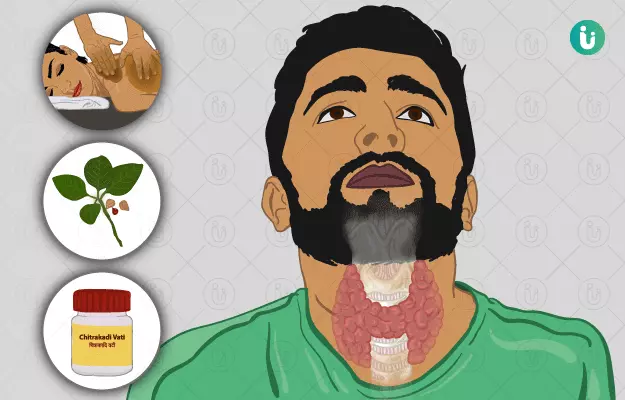Thyroid gland is an endocrine gland located below Adam’s apple in the neck. It produces a number of hormones including, T3 (triiodothyronine) and T4 (thyroxine) hormones. These hormones play a vital role in regulating pulse rate, body temperature, digestion and mood. An overactive or underactive thyroid gland can lead to thyroid conditions such as hypothyroidism and hyperthyroidism, both presenting with their own characteristic symptoms. In Ayurveda, the thyroid gland is not well studied and the most common thyroid conditions are classified under the term galaganda in Ayurveda.
Galaganda is characterised by an enlargement or swelling of the thyroid gland, which could be due to hyperthyroidism (overactive thyroid) or hypothyroidism (underactive thyroid).
People with galaganda may experience hyperthyroidism-related symptoms like shaking, agitation, diarrhoea and rapid heartbeats or may experience hypothyroidism-related symptoms like dry skin, weight gain and constipation. Sometimes galaganda may be asymptomatic. Thyroid cancer, Graves’ disease, being exposed to radiation or thyroiditis are some other causes of galaganda.
Panchakarma (five therapies) therapies including vamana (medical emesis) and virechana (purgation) along with rasayana chikitsa (rejuvenation therapy) help reduce swelling and treat galaganda. External applications like a lepa (coating the affected body part with medications) are also helpful in the treatment of galaganda. Herbs such as nirgundi (five-leaved chaste tree) and ashwagandha (Indian ginseng) and herbal formulations including kanchanar guggulu vati and chitrakadi vati are effective in treating galaganda.
- Ayurvedic view of thyroid problems
- Ayurvedic treatment for thyroid conditions
- Ayurvedic herbs and medicines for thyroid problems
- Dietary and lifestyle changes for thyroid patient as per ayurveda
- How effective are ayurvedic medicines and treatments for thyroid
- Side effects and risks of ayurvedic medicine and treatments for thyroid
- Takeaway
Ayurvedic view of thyroid problems
Ayurvedic texts do not mention thyroid conditions clearly. The very first mention of neck swelling, known as apachi, is found in Atharva Veda. According to Acharya Sushruta, galaganda is a pair of encapsulated swellings in the anterior portion of the neck, which can be big or small and it is seated in the sixth layer of the skin, which is known as Rohini. Acharya Charaka describes galaganda as a solitary swelling and classifies thyroid diseases under endocrine conditions.
Dietary choices, climatic conditions and the surrounding environment are some of the etiological factors in galaganda. According to Ayurvedic medicine, staying in areas with rivers flowing towards the east, contaminated water, living in the eastern part of the country, cold or damp places or in areas with heavy rains as some of the causative factors of galaganda.
Like all the nija rogas (diseases caused due to the vitiation of vata, pitta, kapha), galaganda is also caused due to an imbalance of the doshas. Vitiation of vata and pitta is mostly responsible for hyperthyroidism while hypothyroidism is caused due to an imbalance in kapha, vata and to some extent pitta. Apart from dosha imbalance, thyroid conditions also develop due to imbalances in the channels of meda, rasa and mamsa dhatus, causing them to malfunction.
Alasya (lethargy), hair loss, sthaulya (weight gain), loss of energy, tandra (sleepiness), joint pain, weakness, menstrual abnormalities, impaired memory, aruchi (loss of appetite) are the common symptoms of an abnormally functioning thyroid gland.
Ayurvedic treatment for thyroid conditions
- Nidana parivarjana
- Nidana parivarjana involves avoidance of the causes of a disease and is recommended as the first line of treatment for galaganda.
- This procedure has dual benefits- it puts a stop to the progression of a disease and prevents relapse of the disease.
- Consumption of ruksha (dry) foods, vatika annapana (diet that aggravates vata in the body), alpa bhojana (less quantity of food), katu (pungent) and tikta (bitter) foods are the common nidanas (causes) for any disease.
- Vamana
- Vamana therapy is done to cleanse the stomach and eliminate ama (toxins) from the body.
- Vamana is primarily indicated in people with excess kapha and pitta levels.
- This therapy provides relief from a stiff neck and oedema; therefore, it is beneficial in people with galaganda.
- Vamana is also useful in the treatment of indigestion, bleeding problems, obesity and flatulence.
- Virechana
- Virechana therapy uses purgative herbs and formulations to eliminate vitiated doshas from the body.
- This therapy is particularly useful in removing excess pitta.
- Virechana is also helpful in case of excess kapha dosha as it gets rid of the accumulated phlegm, bile and fat. This makes it useful in managing weight issues that arise due to hypothyroidism.
- It is also effective in treating other health conditions such as bleeding disorders, diseases of the reproductive system and constipation. This therapy helps get rid of blood toxins as well.
- Swedana (sudation or sweat therapy)
- In this procedure, sweating is induced to liquefy doshas so that the body is able to eliminate them with ease. Snehana (oleation) is usually performed before initiating swedana procedures.
- Whole body swedana using a bolus (pinda swedana), jentaka swedana in a sauna room and avagahana swedana, in which, a person is asked to lie down in a tub filled with medicated oil, ghee (clarified butter), milk or kwatha (decoction), are the three main swedana procedures.
- Partial body swedana is also performed to treat localised conditions like joint pain.
- Udwartana (powder massage) along with pachana (digestive) and deepana (appetising) herbs is recommende with swedana for the treatment of hypothyroidism.
- Rasayana
- Rasayana therapy includes the use of rejuvenating herbs like myrrh, chandan (sandalwood), basil, ashwagandha and shatavari (hundred roots) for the treatment of a disease.
- Rasayana therapy increases longevity and promotes healing.
- According to Ayurveda, rasayana herbs improve lifestyle, ethics and spirituality and regenerate body cells and tissues.
- Rasayana therapy is primarily used to treat rasa and meda dhatu in people diagnosed with low thyroid hormone levels.
- Lepa
- Lepas are medicinal plasters used to reduce swelling and are most effective in alleviating inflammatory swelling. Lepas are applied on the affected area against the direction of hair.
- These plasters can include a number of ingredients like vacha (calamus), amalaki (Indian gooseberry) and barley oil.
- A lepa using the root of bharangi (bleeding-heart plant) along with tandulodaka (rice washing) is used to relieve neck swelling in case of thyroid.
Ayurvedic herbs and medicines for thyroid problems
Ayurvedic herbs for galaganda
- Ashwagandha
- Ashwagandha is one of the well-known immunity-boosting herbs in Ayurveda. It is loaded with active compounds which help in delaying ageing. Ashwagandha is also effective in treating skin conditions, ulcers, memory loss, emaciation (being overly thin or weak) and muscle energy loss.
- This herb helps reduce swelling; therefore, it is useful in people with neck swelling due to galaganda.
- The properties of ashwagandha also help regulate hormone levels in body, which is one of the primary causes of thyroid problems.
- You can take ashwagandha in the form of a powder with ghee, oil, herbal wine, decoction or as per your physician’s direction.
Transform your well-being with Ashwagandha. Order now for hormonal balance and stress relief Urjas Ashwagandha Tablet by myUpchar Ayurveda. Elevate your health journey today.
- Nirgundi
- Nirgundi acts on the circulatory, nervous and reproductive systems.
- This herb has pain-relieving, anti-parasitic, aromatic and vermifuge (kills worms) properties.
- It is used in treating piles, ulcers, malaria, contusions, sprain and other health conditions.
- The leaves of nirgundi reduce inflammatory joint swellings in rheumatism and can also be effective in reducing neck swelling caused due to thyroid problems.
- You can take nirgundi in the form of a decoction, paste, powder with honey/water/sugar, poultice, tincture, fresh leaf juice or as per your physician’s direction.
- Vacha
- Vacha acts on the nervous, respiratory, reproductive and digestive systems.
- It has rejuvenating, anti-spasmodic, stimulant, nervine (soothes nerves) and expectorant (expels phlegm) properties.
- Vacha is used to treat cold, insanity, nasal congestion, polyps, asthma and arthritis.
- Vacha reduces pain and acts as a rejuvenator in people with vitiated vata and kapha. Therefore, it is useful for treating kapha–related disorders like galaganda.
- You can take vacha in the form of a decoction, paste, milk decoction or powder.
Ayurvedic medicines for galaganda
- Kanchanar guggulu
- Kanchanar guggulu consists of kanchanar (orchid tree) bark, trikatu, [a combination of the three acrids – pippali (long pepper), shunthi (dried ginger) and maricha (black pepper)], dalchini (cinnamon), ela (cardamom), guggulu (Indian bdellium tree) and other ingredients.
- It is mainly indicated in the treatment of gandamala (swelling in the neck) and is used to reduce swelling in thyroid.
- You can take kanchanar guggulu with lukewarm water or as per your physician’s direction.
- Dashamoola kwatha
- Dashamoola kwatha is prepared from bilwa (wood apple), patla (fragrant padri tree), gokshura (small caltrops), kashmari (malay beechwood) and other ingredients formulated into a decoction.
- It is used to treat paralysis, hikka (hiccups) and ardit (facial paralysis).
- This medicine is also helpful in treating vatavyadhi (a disease caused due to the aggravation of vata).
- Dashamoola kwatha is a standard pain relieving medicine in Ayurveda. Also, it has anti-inflammatory properties, which together with its analgesic properties, help reduce painful swelling in the thyroid gland.
- Varunadi kwatha
- This formulation is made from shatavari, chitraka (leadwort), sahachar (lesser kurinji) and 17 other ingredients.
- Varunadi kwatha is used to provide relief from headaches, anorexia and rheumatic complaints.
- It helps treat obesity and can thus be effective in the management of weight gain issues caused due to thyroid abnormalities.Varunadi kwatha acts effectively on inflammations, thus reducing pain and swelling.
- Gomutra haritaki vati
- Gomutra haritaki vati is prepared by mixing haritaki (chebulic myrobalan) churna with gomutra (cow’s urine).
- This medicine is used to treat dhamanipratichaya (hypertension), pandu (anaemia), medoroga (diseases of the meda dhatu), pleehadosha (disorders of the spleen) and mutraghat (obstruction in urination).
- Gomutra haritaki vati helps reduce shotha (swelling). Therefore, it is useful in treating neck swelling in those diagnosed with galagand.
- You can take gomutra haritaki vati with lukewarm water or as per your physician’s direction.
- Chitrakadi vati
- Chitrakadi vati is prepared using the root of chitraka, pippali moola, panchalavana, trikatu, hingu (asafoetida), ajamoda (caraway), yavakshar (alkali prepared from the ashes of green barley-corns) and other herbs.
- This combination of herbs then mixed with ginger juice or lemon juice to prepare a tablet.
- Chitrakadi vati is helpful in treating vataja grahani (irritable bowel syndrome caused due to vitiated vata) and hypothyroidism.
- You can take chitrakadi vati with lukewarm water or as per your physician’s direction.
As treatments vary according to numerous factors and an individual’s prakriti (constitution), consult a qualified Ayurvedic doctor for the appropriate medications and treatments for your specific complaints.
Dietary and lifestyle changes for thyroid patient as per ayurveda
Do’s
- Include drumsticks, pearl millet, yava (barley), radish, shunthi, lukewarm water, bajra (millet), ragi, oats, mudga (green gram), patola (pointed gourd) leaves, gandeera (coleus), buttermilk and other kapha-reducing foods in your meals.
- Exercise regularly.
- Perform pranayama poses like kapalbhati and surya bhedana.
- Avoid sleeping during the day.
- Use sea salt.
Don’ts
- Do not eat fried and heavy foods.
- Do not eat refined foods, curd, white flour, potatoes, milk, black gram and peas.
- Do not consume fermented and baked foods.
- Do not follow a sedentary lifestyle.
- Do not eat constantly throughout the day
How effective are ayurvedic medicines and treatments for thyroid
In a double-blind study, which was conducted to assess the effects of ashwagandha root extract on thyroid function, 50 people with subclinical hypothyroidism were separated into two groups. 25 people were given 600 mg of ashwgandha root extract daily (test group) and the other 25 were on placebo for a period of eight weeks. At the end of the study, significant improvement was reported in thyroid function in most of the test subjects with mild to no side effect. It was concluded that ashwagandha may be used in regulating thyroid function in cases of subclinical hypothyroidism.
According to an article published in the International Journal of Ayurveda and Pharma Research, kanchanar guggulu has anti-inflammatory properties and it helps in regulating thyroid gland function. In a clinical study done in India, 15 people diagnosed with hypothyroidism were administered kanchanar guggulu along with another ayurvedic medicine for a period of 12 weeks and phalatriikadi lekhana basti for 30 days. At the end of the designated period, the T3, TSH and T4 levels were found to be improved in all patients. Hypothyroidism symptoms were also reported to be improved significantly.
Side effects and risks of ayurvedic medicine and treatments for thyroid
Ayurvedic medicines and treatments are considered to be safe when taken under the guidance of an experienced doctor. However, depending on individual prakriti and doshas, certain treatments may have negative effects on some people. For eg.:
- Vamana is contraindicated in case of pregnancy. It should not be given to weak and elderly people and those with a weak digestive fire or high blood pressure.
- Virechana is not recommended in people who recently had fever. People with a weak digestive system, rectal ulcers, diarrhoea, piles and bleeding diseases should not undergo virechana.
- People with congestion should not take ashwagandha.
- Individuals with bleeding disorders like piles and nosebleeds should not take vacha. Excessive use of vacha might cause vomiting, rashes, nausea and other pitta-related conditions.
Takeaway
Unhealthy diet and a sedentary lifestyle are the major causes of most health conditions and abnormal thyroid function is no different. An underactive or overactive thyroid affects body functions by creating an imbalance in thyroid hormones. It leads to many health conditions like galaganda, which has a direct impact on the quality of life. Ayurvedic procedures of vamana and virechana help bring back balance in the affected doshas, and external applications like lepas minimise neck swelling in case of galaganda. Ayurvedic treatment of galaganda also comprises herbs and medicines to improve thyroid function and overall health. Unlike conventional medications, Ayurvedic medications do not show any side effects or adverse effects when taken appropriately and under the guidance of an experienced doctor.
Find Ayurvedic Doctor in cities
Doctors for Ayurvedic medicine, treatment and remedies for Thyroid

Dr. Ayush Bansal
Ayurveda
2 Years of Experience

Dr. Megha Sugandh
Ayurveda
6 Years of Experience

Dr. Nadeem
Ayurveda
3 Years of Experience

Dr.Ashok Pipaliya
Ayurveda
12 Years of Experience
References
- Cleveland Clinic. [Internet]. Cleveland, Ohio. Goiter
- Kundu Debasis, Doijode Rekha, Bhosgikar Anup. [link]. Journal of Ayurveda and Integrated Medical Sciences. May- June 2017 Vol.2 Issue 3.
- Sahu Dustidev, Gupta Mahesh Chand, Indoria Anooopkumar. “Hypothyroidism” An Ayurvedic Perspective – A Critical Review. International Ayurvedic Medical Journal : Volume 3; Issue 1; January - 2015
- Scott Gerson. Ayurveda Perspective on Hypothyroidism. SomaVeda College of Natural Medicine. Brooksville, Florida. [Internet].
- Deepthi Viswaroopan et al. Undernutrition In Children: An Updated Review. Int. J. Res. Ayurveda Pharm. 8 (Suppl 2), 2017.
- Oushadhi. Kashaya Choornam & Sookshma Choornam. Govt of Kerala. [Internet]
- K. Bharathi1, C.M. Jain, B. Pushpalatha. [link]. International Journal of Ayurveda and Pharma Research. 2013; 1(3): 30-35.
- National Institute of Indian Medical Heritage (NIIMH). Diseases. Central Council for Research in Ayurvedic Sciences (CCRAS); Ministry of AYUSH, Government of India.
- Rajiv Gandhi Government Post Graduate Ayurvedic College. Kayachikitsa. Paprola, Himachal Pradesh. [Internet]
- Ashutosh Kumar Pathak , H. H. Awasthi , Ajai Kr. Pandey. [link]. Journal of AYUSH: Ayurveda, Yoga, Unani, Siddha and Homeopathy Volume 4, Issue 1.













